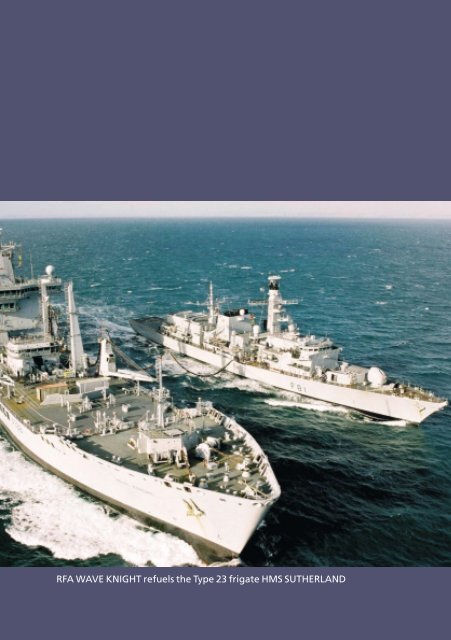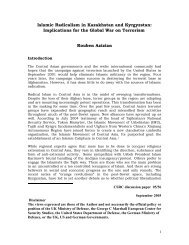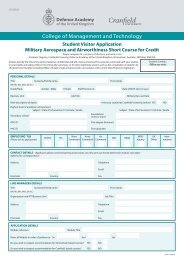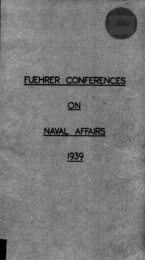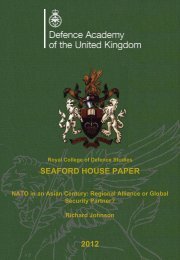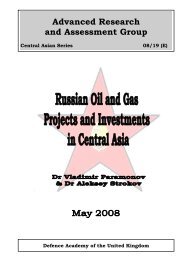Chapter 5 — Maritime Logistics and Support
Chapter 5 — Maritime Logistics and Support
Chapter 5 — Maritime Logistics and Support
You also want an ePaper? Increase the reach of your titles
YUMPU automatically turns print PDFs into web optimized ePapers that Google loves.
RFA WAVE KNIGHT refuels the Type 23 frigate HMS SUTHERLAND
5<br />
<strong>Maritime</strong> <strong>Logistics</strong><br />
<strong>and</strong> <strong>Support</strong><br />
The purpose of logistic support is to ensure the provision, sustainment<br />
<strong>and</strong> recovery of forces, thus enabling the maintenance of combat capability<br />
<strong>and</strong> allowing the operational comm<strong>and</strong>er to deploy forces at the time <strong>and</strong><br />
place of his choosing. Logistic support includes medical <strong>and</strong> repair<br />
facilities, movement of personnel, <strong>and</strong> the transport of the fuel, lubricants,<br />
ordnance, spare parts, food <strong>and</strong> other provisions, <strong>and</strong> the many stores<br />
required for missions. The sea will remain the principal transport medium<br />
for large, heavy <strong>and</strong> bulky items. Ships are, therefore, important joint<br />
logistics assets. The availability of shipping <strong>and</strong> the ability to transfer ashore<br />
may ultimately govern whether, where <strong>and</strong> when military operations can<br />
take place. However, the use of sea lines of communications to a campaign<br />
may be considered a critical vulnerability, <strong>and</strong> shipping may require<br />
protection, increasingly so against the threat of asymmetric attack.<br />
Similarly, at the tactical level, a formation’s organic logistic shipping will<br />
invariably be essential to its mission <strong>and</strong> thus require special effort to be<br />
devoted to its protection.<br />
The ability of ships to carry <strong>and</strong> transfer stores <strong>and</strong> fuel allows maritime<br />
forces to conduct self-sustained operations at considerable distances from<br />
fixed bases with little or no Host Nation <strong>Support</strong> (HNS) required. Indeed the<br />
sailor is so used to the level of organic logistics support that is provided<br />
routinely in a ship <strong>and</strong> its tactical formation that logistic considerations are<br />
intrinsic to maritime doctrine. For the operational comm<strong>and</strong>er, maritime<br />
93
BRITISH MARITIME DOCTRINE / THIRD EDITION<br />
<strong>and</strong> l<strong>and</strong> logistics are not conceptually dissimilar, because the ability to use<br />
lines of communications along which a maritime force is consolidated, is<br />
comparable with tasks relating to seaborne support of l<strong>and</strong> operations <strong>and</strong><br />
to l<strong>and</strong> lines of communications. In any event, logistic support is a<br />
fundamental activity in which resources <strong>and</strong> facilities must be pooled <strong>and</strong><br />
focused to sustain a joint campaign in all its phases <strong>and</strong> environments. It is<br />
a tenet of joint doctrine that administrative services of common usage in<br />
the three Services can be provided by one Service for the use of others. At<br />
the operational level, logistic policy, planning <strong>and</strong> execution will be jointly<br />
co-ordinated.<br />
<strong>Maritime</strong> logistics support to joint operations comes with two important<br />
advantages. Joint sea basing of logistics support optimises the ‘footprint’<br />
ashore <strong>and</strong> allows that support to be l<strong>and</strong>ed in sufficient quantities as<br />
required without necessarily placing it all in a vulnerable <strong>and</strong> essentially<br />
immobile location. Sea basing also allows for the protection of logistics<br />
support, especially important in operational environments that may be<br />
affected by weapons of mass destruction (WMD) or asymmetric attack.<br />
<strong>Logistics</strong> at the Strategic Level<br />
At the strategic level, the logistics process provides the link between the<br />
resources of the nation <strong>and</strong> the military operations of combat forces. The<br />
creation of logistic resources (or production logistics) is almost entirely a<br />
civilian commercial process. Once they are manufactured, the employment<br />
of these resources in support of military operations (consumer logistics)<br />
becomes a military function, albeit one heavily dependent on civilian<br />
support. The integration of production <strong>and</strong> consumer logistic systems<br />
takes place at the military-strategic level <strong>and</strong> is the responsibility of the<br />
Chief of Defence <strong>Logistics</strong> (CDL). The determination of strategic<br />
requirements, procurement, planning of logistic aspects of regeneration<br />
capability, central storage <strong>and</strong> bulk distribution are all military-strategic<br />
logistic functions.<br />
<strong>Logistics</strong> at the Operational Level<br />
<strong>Maritime</strong> operational logistic functions are:<br />
94
BRITISH MARITIME DOCTRINE / THIRD EDITION<br />
hoc coalitions where there may be little st<strong>and</strong>ardisation between nations’<br />
equipments. However, NATO has developed Allied Joint <strong>Logistics</strong> Doctrine<br />
encompassing a principle of collective responsibility between member<br />
nations <strong>and</strong> Allied authorities, although specific national requirements,<br />
especially in ammunition resupply <strong>and</strong> the maintenance <strong>and</strong> repair of<br />
weapon systems, still limit the effectiveness of multinational logistics. The<br />
doctrine includes the establishment of a Multinational Logistic<br />
Comm<strong>and</strong>er (MNLC) to plan, co-ordinate <strong>and</strong> control all maritime logistic<br />
shore support <strong>and</strong> a Multinational Joint <strong>Logistics</strong> Centre (MJLC) to coordinate<br />
theatre wide logistic support for all components. Interoperability<br />
within an alliance is a prerequisite if one nation’s logistic resources are to<br />
support another’s, <strong>and</strong> considerable work in NATO’s st<strong>and</strong>ardisation<br />
agencies is devoted to this end. St<strong>and</strong>ardisation of fuel grades,<br />
replenishment rigs <strong>and</strong> connections allow for regular transfer of fuel<br />
between NATO nations <strong>and</strong>, indeed, between other nations that have<br />
adopted NATO st<strong>and</strong>ards. Medical support, supply of provisions <strong>and</strong><br />
general stores, <strong>and</strong> non-specialist transport can generally be treated as<br />
common resources.<br />
Logistic Principles<br />
The principles of joint logistics are foresight, economy, flexibility, simplicity<br />
<strong>and</strong> co-operation. The need for foresight in logistic planning has been<br />
discussed earlier in this chapter, as has the requirement for co-operation<br />
between Services, nations <strong>and</strong> comm<strong>and</strong>s, particularly where control of<br />
logistics is not unified. Economy, flexibility <strong>and</strong> simplicity deserve special<br />
mention.<br />
Economy<br />
<strong>Logistics</strong> resources will usually be in short supply <strong>and</strong> sufficiency should be<br />
the objective of the logistician. It is possible to overplan as well as to<br />
underplan logistic requirements. Over-planning can consume resources<br />
that could be devoted to combat forces. Furthermore, an over-large<br />
logistic organization may require additional logistics staff who, in turn, will<br />
need logistic support, <strong>and</strong> the whole may draw forces for protection away<br />
from the main effort.<br />
96
MARITIME LOGISTICS AND SUPPORT<br />
5<br />
Flexibility<br />
A logistic plan must be capable of responding to the inevitable changes in<br />
any operational plan. Equally, the logistic system that executes the plan<br />
must be capable of adapting to rapid changes of requirement. A large<br />
logistics organization geared to supporting a major campaign can acquire a<br />
momentum of its own <strong>and</strong> generate wasteful stockpiles of materiel, if it is<br />
not sensitive to change. It may also be necessary for an operational<br />
comm<strong>and</strong>er to take a calculated risk over logistic sufficiency, in particular<br />
where there are opportunities to exploit success or to maintain tempo. For<br />
example, he may allow the fuel <strong>and</strong> ammunition levels of a naval force that<br />
is exploiting success to fall below prudent norms in the expectation that<br />
consolidation forces will arrive. A flexible logistic system will minimise<br />
differences between operational <strong>and</strong> logistic tempo <strong>and</strong> therefore the<br />
attendant risk. It is relevant that a major reason for the planning of<br />
operational pauses in a campaign is to allow the consolidation of logistics<br />
<strong>and</strong> to avoid reaching culmination before success is achieved.<br />
Simplicity<br />
Any unnecessarily complicated aspect of operational planning will be<br />
prone to disruption. Logistic planning is in large part carried out by experts<br />
<strong>and</strong> can appear intractable to non-experts charged with assessment <strong>and</strong><br />
execution. The principal non-expert may be the operational comm<strong>and</strong>er.<br />
A comprehensive, but simple, plan that accords with the direction given by<br />
the operational comm<strong>and</strong>er is more likely to gain approval <strong>and</strong> be correctly<br />
interpreted <strong>and</strong> executed.<br />
Roulement<br />
Consideration must be given at an early stage in strategic <strong>and</strong> operational<br />
planning to relieving maritime forces <strong>and</strong> personnel likely to be in an<br />
operational theatre for an extended period. Although ships, given<br />
sufficient logistic support, can remain on station almost indefinitely, the<br />
efficiency of personnel can be expected to decline during deployment.<br />
Furthermore, some aspects of maintenance may suffer if the tempo of<br />
operations is high. The rotation of ships <strong>and</strong> personnel on station to<br />
maintain a high state of readiness is known as roulement <strong>and</strong> is an<br />
important feature of the maritime component of a campaign plan.<br />
97
BRITISH MARITIME DOCTRINE / THIRD EDITION<br />
Shore <strong>Support</strong><br />
Shore support, whether at home or abroad, provides the starting point for<br />
any maritime logistic chain. The home base will provide the main supply<br />
depots <strong>and</strong> dockyard facilities. Most supplies <strong>and</strong> repairs are obtained from<br />
the private sector under contract. Procurement of materiel must be<br />
carefully monitored both to ensure that adequate stocks of equipment <strong>and</strong><br />
stores are available for transfer to the fleet <strong>and</strong> to avoid wasting resources<br />
in the production <strong>and</strong> retention of unnecessarily large stocks. When HNS is<br />
available, it may supplement afloat support by providing useful forward<br />
airheads <strong>and</strong> seaports for logistic <strong>and</strong> personnel movements to <strong>and</strong> from<br />
the theatre of operations, <strong>and</strong> forward operating bases for replenishment,<br />
maintenance <strong>and</strong> repair. HNS may help to economise on the need for<br />
logistics, but such support is not an essential feature of purely maritime<br />
operations. Indeed, a forward operating base may be no more than a<br />
sheltered anchorage for a support or repair ship. However, once troops are<br />
ashore, the significance <strong>and</strong> dimensions of the organization to co-ordinate<br />
<strong>and</strong> take advantage of HNS can increase substantially. HNS arrangements<br />
are often pre-planned in outline <strong>and</strong> formalised by inter-governmental<br />
Memor<strong>and</strong>a of Underst<strong>and</strong>ing (MOU). They are, nevertheless, not<br />
guaranteed to remain in force as the situation changes. Lack of HNS may<br />
cause the emphasis of an operation to remain with maritime logistics<br />
support.<br />
Sustained Reach<br />
No maritime force is complete without support vessels to provide fuel <strong>and</strong><br />
other essential stores. An integral part of the Fleet, the Royal Navy’s logistic<br />
shipping is organized as the Royal Fleet Auxiliary (RFA), manned by<br />
personnel employed under Merchant Navy articles, <strong>and</strong> whose officers<br />
provide afloat support expertise on Comm<strong>and</strong> staffs. Replenishment at<br />
Sea (RAS) from auxiliary ships enables naval forces to extend their reach<br />
world wide without the need to enter port. The RFA, supplemented where<br />
necessary by chartered vessels, gives British maritime forces a unique<br />
capability to carry out sustained operations at considerable distances from<br />
their home base, <strong>and</strong> the UK continues to maintain considerable<br />
investment in these ships; the effort is enhanced by in-theatre<br />
98
MARITIME LOGISTICS AND SUPPORT<br />
5<br />
consolidation <strong>and</strong> the provision of air based supply. The mechanism for<br />
obtaining shipping from the commercial sector is well established <strong>and</strong>, in<br />
crisis, early identification of the need for chartered shipping is important if<br />
forces containing such vessels are to be formed in a timely fashion.<br />
MV MAGDALENA GREEN,<br />
chartered in support of<br />
operations in the Arabian Gulf,<br />
with RFA FORT VICTORIA in the<br />
background<br />
99
BRITISH MARITIME DOCTRINE / THIRD EDITION<br />
The <strong>Maritime</strong> Operational <strong>Logistics</strong> Pipeline<br />
The sustained reach of maritime forces <strong>and</strong> the reach that they in turn<br />
provide to other forces are key components of maritime power. However,<br />
military <strong>and</strong> RFA support shipping form only a part of the maritime logistic<br />
system. Figure 5.1 shows the extent of the Operational <strong>Logistics</strong> Pipeline<br />
from the UK bases to the furthest forward fighting unit. The Pipeline may<br />
include an Advanced Logistic <strong>Support</strong> Site (ALSS) <strong>and</strong>, potentially, several<br />
Forward <strong>Logistics</strong> Sites (FLS) within the operational theatre. The<br />
establishment <strong>and</strong> maintenance of these sites, together with the provision<br />
of transport between them, will, in most cases, be a joint <strong>and</strong> frequently<br />
multinational requirement. The locations of the ALSS <strong>and</strong> FLS would be<br />
chosen to provide optimal support to the campaign <strong>and</strong> may need to move<br />
if the situation changes.<br />
The pipeline must h<strong>and</strong>le the movement of materiel <strong>and</strong> people into,<br />
within <strong>and</strong> from the operational area. Personnel may include casualties,<br />
refugees, displaced persons <strong>and</strong> prisoners of war. Segments of the pipeline<br />
may consist of air, l<strong>and</strong> or sea transport, which could be supporting all three<br />
Services as well as multinational requirements. Priorities across<br />
commodities, services <strong>and</strong> nations will need to be established to cater for<br />
constraints on transport capacity.<br />
5/1. El Alamein.<br />
“Rommel greatly underestimated the importance of Naval cooperation<br />
during this campaign…..I was not in favour of the Alamein<br />
offensive because of the impossibility of maintaining the lines of<br />
supply.”<br />
(Vice Admiral Weichold, German Comm<strong>and</strong>er-in-Chief Mediterranean)<br />
100
MARITIME LOGISTICS AND SUPPORT<br />
5<br />
Supplying Montgomery<br />
Montgomery’s strategy at Alamein was entirely dependent on the safe<br />
delivery of supplies <strong>and</strong> reinforcements drawn from across the globe.<br />
The principal supply route ran from Britain <strong>and</strong> the United States,<br />
around the Cape of Good Hope <strong>and</strong> up through the Red Sea, a distance<br />
of 14,000 miles. During the five months leading up to the Alamein<br />
offensive 8th Army was massively reinforced <strong>and</strong> re-equipped via this<br />
route, with over 97% of cargoes <strong>and</strong> more than 99% of troops arriving<br />
without loss.<br />
Concluding comments<br />
The accurate preparation, sequencing <strong>and</strong> positioning of logistics in<br />
peacetime, <strong>and</strong> the seamless underst<strong>and</strong>ing between logisticians <strong>and</strong><br />
warfare specialists at each level of comm<strong>and</strong>, are fundamental to the<br />
success of operations throughout the spectrum of likely tasks. Modern<br />
joint operations will only retain their effect when complemented by<br />
flexible, mission focused logistics drawing together single-Service, joint<br />
<strong>and</strong> civilian elements.<br />
101
BRITISH MARITIME DOCTRINE / THIRD EDITION<br />
FIG 5.1 – THE O<br />
OPERATIONAL LOGISTICS PIPELINE<br />
Industry<br />
Depots<br />
SPOE/<br />
APOE<br />
ALSS<br />
/FMB<br />
FLS<br />
APOD/<br />
SPOD<br />
FRONT<br />
LINE<br />
UNITS<br />
Sea/Air/L<strong>and</strong><br />
Transportation<br />
Sea/Air/L<strong>and</strong><br />
Transportation<br />
Consolidation<br />
Underway Replenishment<br />
or FLS<br />
Dockyard<br />
Salvage<br />
Forward<br />
Repair Ship<br />
Hospital<br />
APOD/<br />
SPOD<br />
ALSS<br />
Joint Casualty<br />
Treatment Ship<br />
Fig 5.1<br />
102
MARITIME LOGISTICS AND SUPPORT<br />
5<br />
The Royal Fleet Auxiliary FORT GEORGE<br />
103


